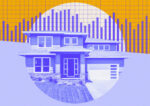Chicago’s housing market has jogged at its own pace while other cities sprinted ahead since the turn of the century.
The city’s home prices have doubled in the last 25 years, but that growth significantly lags home values of most major U.S. metro, according to the S&P CoreLogic Case-Shiller Indices, Crain’s reported.
Chicago’s price index landed at just 211.23, placing it near the bottom of the 20-city list, while the national average has more than tripled since January 2000. Markets like Miami, San Diego and Los Angeles have seen prices quadruple since then.
The slower climb reflects strengths and weaknesses in Chicago’s housing market.
The lack of a dramatic run-up means affordability is strong, making Chicago an attractive place to live even if it doesn’t offer the same wealth gains as pricier coastal cities, said Karen Ranquist of Jameson Sotheby’s International Realty.
The market has shown resilience in the short term. Case-Shiller showed Chicago leading most major metros in year-over-year price growth in January, second only to New York. That strength reflects a more stable post-pandemic market compared to places like Phoenix and Tampa, where prices surged and then cooled rapidly.
The long-term lag is tied to deeper structural challenges. Population loss, slow economic growth and the lasting impact of the foreclosure crisis and pandemic downturns are drags on appreciation.
Local markets have also diverged. Historically disinvested areas like Bronzeville and Humboldt Park have seen substantial appreciation driven by reinvestment and redevelopment, while parts of South Cook County have struggled from the decline of industrial jobs.
Chicago’s real estate story is more about stability than speculation despite the uneven gains, with steady demand and an improving outlook for this year.
More recently, Chicago home prices have leapt, outpacing inflation with a 7 percent surge in mid-2024 and the market remaining active at the start of the year.
Sellers began cutting prices earlier than usual this winter as high interest rates and buyer caution tempered demand. Median asking prices hit $410,000 in February, marking a three-year high, and overall values remain 4 to 5 percent above last year’s levels, suggesting pricing power hasn’t vanished even as buyers grow more selective.
— Judah Duke
Read more



